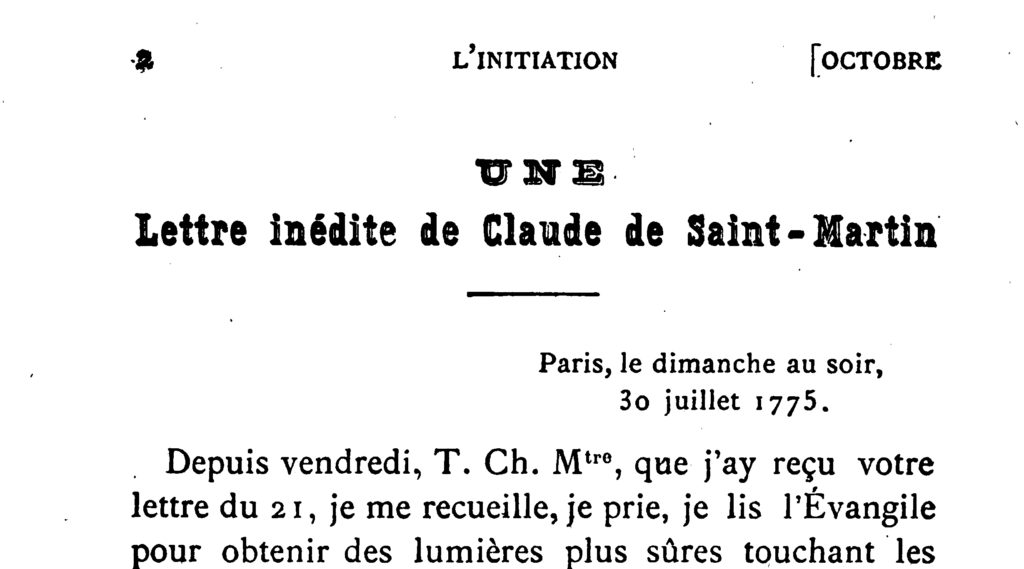More on the human side of Saint-Martin
Following an earlier post about Baron von Gleichen’s views of Louis-Claude de Saint-Martin, which gave an insight into how meetings of the disciples with their Master worked, now you can read a letter from the man himself!
All these insights give us a broader picture of Saint-Martin the man, rather than Saint-Martin the Theosophist. Indeed, while many pages have been written about him – especially in French – it is always fascinating to return to those times and see letters and notes from the Master and those who lived and studied alongside him. One of the benefits of this is that we can perform a kind of modern exegesis on important issues over which many historians still argue, and attempt to draw our own conclusions based upon the evidence. Like biblical exegesis, the closer a source is to the event the more weight it is given: so documents written centuries after the death of Jesus are probably going to contain more inaccuracies, more fantasies and more wishful thinking than those written closer to the time he lived.
It’s the same with Saint-Martin. One of the most controversial questions about the man is whether he founded his own movement and whether he initiated and taught disciples. Now, we can’t go back in time, so our conjectures will never be one hundred percent foolproof. However, we can draw on evidence to give us a prevailing balance of support to our hypothesis. In this instance, historians come down firmly on one side or the other, almost inevitably depending upon their view of Martinism as an Order. There seems to be no middle path: either it is self-evident that Saint- Martin ran a school of learning for initiates, or the entire idea is poppycock!
Baron von Gleichen’s Memoirs, therefore, help shed some light on this. He was what is know as a primary source, in that he wasn’t reporting facts secondhand or centuries later, like many historians, or even quoting sources from other people who had written opinion pieces or conjectures: he was there! When he says he attended meetings where the Master was present and they talked (note ‘they’, not a single person), it is clear that Saint-Martin met with groups and they discussed his ideas, just as he, Willermoz and d’Hauterive had discussed Pasqually’s ideas in the Lessons of Lyon held in Willermoz’ home some years earlier. This is not distant wishful thinking, but an eye-witness account of a respectable person who had no reason to lie.
Similarly, when Léon Chauvin, the lawyer and executor of the estate of Joseph Gilbert, to whom Saint-Martin had bequeathed his archives and unpublished materials, wrote his memoir of the many meetings these two old friends had, it’s hard to discount the important comments made by Gilbert concerning his time with Saint-Martin:
“During that space of a year Gilbert hardly left him, and it was in long discussions every day that he got all the clarifications he wanted. He would even have received the Initiations if circumstances had brought together the number of initiates required for that ceremony, but despite his good intentions, Saint-Martin couldn’t cover the distances which separated them from his old disciples, who had been scattered by the revolutionary storm, before his death.”
This was in the year before Saint-Martin’s death in 1803, so he wouldn’t have been talking about resurrecting the Elus Cohen rituals of Martinès de Pasqually for such an occasion! Also, note that more than one person was needed to perform the initiation. Now, the source isn’t primary, but as a secondary contemporary report it’s as close to that as one can get. Again, this honorable man had no reason to lie: he was simply stating facts, and clearly not supporting a partisan point of view.
I like to think that Saint-Martin did indeed have a small circle of intimates on whom he performed some kind of gentle initiation or induction. He taught as a tutor rather than as a worker of wonders or a despot, preferring to allow everyone to talk instead of imposing his views (as we learn from von Gleichen’s Memoirs) and as he said of other schools: “…and those who teach there do so only by demonstrating marvelous things, or by requiring submission” (letter from Saint-Martin dated August 5th, 1798). And I like to think that the Initiation was based on simple Elus Cohen prayers or prayers from his own collection, and that the Initiation was performed by three people. Why? Because that would accord both with his Masonic roots, and with the Christic injunction for two or three to gather together in His name.
In the meantime, here is a letter from Saint-Martin to Willermoz, dated July 3rd, 1775, in the middle of when the Lessons of Lyon were being held. Saint-Martin is returning to Lyon, but is nervous about staying with his old friend, Jean-Baptiste Willermoz. He is losing interest in conventional Freemasonry, and is also concerned that if he stays with Willermoz he will be giving up his personal freedom. He therefore asks his friend to find him a house on the West side of the river on Gouguillon Hill, and to agree to a pretext to be used to dispel any concerns their mutual friends might have over this apparent estrangement. He uses a curious term for one of the rooms he wants in the house, a physical area. I consulted with Mathieu Ravignat, and he suggested from the French root that Saint-Martin was probably coyly referring to a private room where he could perform his Elus Cohen operations. As so often happens in these letters, he ends by asking his dear friend for a loan!
You can find the letter here: SM Letter from l’Initiation in English




No Comments